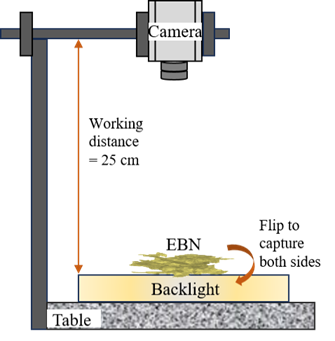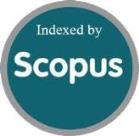Modeling and Suppression of Inhomogeneous Intensity Edible Bird Nest Images for Impurity Segmentation Using β-Variational Autoencoder
DOI:
https://doi.org/10.46604/peti.2024.13998Keywords:
edible bird’s nest (EBN), impurity segmentation, intensity inhomogeneity (IIH), β-variational autoencoder (β-VAE), anomaly detectionAbstract
This study proposes a β-variational autoencoder (β-VAE) method to address intensity inhomogeneity (IIH) in edible bird’s nest (EBN) images, which creates an uneven intensity that obscures fine impurity details and reduces segmentation accuracy. First, the β-VAE is used to learn the feature distribution of EBN images by mapping them into a latent space. This latent space is then disentangled through selective filtering and penalization of specific latent dimensions. This unsupervised learning approach effectively captures and isolates IIH in EBN images. Additionally, enabling precise segmentation of EBN and impurities without requiring annotated datasets. It also enhances robustness in handling unseen image instances. The proposed method achieves an intersection over union of 73.08% (equivalent to a Dice coefficient of 84.44%), surpassing existing segmentation techniques. By resolving IIH, this method improves the reliability and adaptability of automated EBN inspection systems for practical applications.
References
T. H. Lee, S. Wong, C. H. Lee, N. A. Azmi, M. Darshini, S. Kavita, et al., “Identification of Malaysia’s Edible Bird’s Nest Geographical Origin Using Gel Electrophoresis Analysis,” Chiang Mai University Journal of Natural Sciences, vol. 19, no. 3, pp. 379-392, 2020.
Q. Fan, X. Liu, Y. Wang, D. Xu, and B. Guo, “Recent Advances in Edible Bird's Nests and Edible Bird's Nest Hydrolysates,” Food Science and Technology, vol. 42, article no. 67422, 2022.
A. F. El Sheikha, “Why the Importance of Geo-Origin Tracing of Edible Bird Nests is Arising ?,” Food Research International, vol. 150, no B, article no. 110806, 2021.
V. Venkatesh, N. Sharma, and M. Singh, “Intensity Inhomogeneity Correction of MRI Images Using InhomoNet,” Computerized Medical Imaging and Graphics, vol. 84, article no. 101748, 2020.
N. A. S. Ahmad Shuyuti, E. Salami, M. Dahari, H. Arof, and H. Ramiah, “Application of Artificial Intelligence in Particle and Impurity Detection and Removal: A Survey,” IEEE Access, vol. 12, pp. 31498-31514, 2024.
K. M. Goh, L. L. Lim, S. Krishnamoorthy, W. K. Lai, T. Maul, and J. K. Chaw, “Recent Advancement of Intelligent-Systems in Edible Birds Nest: A Review from Production to Processing,” Multimedia Tools and Applications, vol. 83, pp. 51159-51209, 2023.
C. Acharya and N. Satheesh, “Edible Bird’s Nest (EBN): Production, Processing, Food and Medicinal Importance,” vol. 4, no. 3, pp. 20-25, 2023.
T. K. Hong, C. F. Choy, and A. O. H. Kait., “Approach to Improve Edible Bird Nest Quality & Establishing Better Bird Nest Cleaning Process Facility through Best Value Approach,” Journal for the Advancement of Performance Information and Value, vol. 10, no. 1, pp. 38-50, 2018.
F. S. A. Saad, A. Y. M. Shakaff, A. Zakaria, M. Z. Abdullah, A. H. Adom, and A. A. M. Ezanuddin, “Edible Bird Nest Shape Quality Assessment Using Machine Vision System,” Proceedings of 3rd International Conference on Intelligent Systems, Modelling and Simulation, pp. 325-329, 2012.
K. C. Chok, M. G. Ng, K. Y. Ng, R. Y. Koh, Y. L. Tiong, and S. M. Chye, “Edible Bird's Nest: Recent Updates and Industry Insights Based On Laboratory Findings,” Frontiers in Pharmacology, vol. 12, article no. 746656, 2021.
Y. Subramaniam, Y. C. Fai, and E. S. L. Ming, “Edible Bird Nest Processing Using Machine Vision and Robotic Arm,” Jurnal Teknologi, vol. 72, no. 2, pp. 85-88, 2015.
K. M. Goh, W. K. Lai, P. H. Ting, K. Daniel, and J. K. R. Wong, “Size Characterisation of Edible Bird Nest Impurities: A Preliminary Study,” Procedia Computer Science, vol. 112, pp. 1072-1081, 2017.
C. K. Yee, Y. H. Yeo, L. H. Cheng, and K. S. Yen, “Impurities Detection in Edible Bird’s Nest Using Optical Segmentation and Image Fusion,” Machine Vision and Applications, vol. 31, article no. 68, 2020.
K. L. Gwee, L. H. Cheng, and K. S. Yen, “Optimization of Lighting Parameters to Improve Visibility of Impurities in Edible Bird’s Nest,” Journal of Electronic Imaging, vol. 28, no.2, article no. 023014, 2019.
Y. H. Yeo and K. S. Yen, “Impurities Detection in Intensity Inhomogeneous Edible Bird’s Nest (EBN) Using a U-Net Deep Learning Model,” International Journal of Engineering and Technology Innovation, vol. 11, no. 2, pp. 135-145, 2021.
Y. H. Yeo and K. S. Yen, “Development of a Hybrid Autoencoder Model for Automated Edible Bird’s Nest Impurities Inspection,” Journal of Electronic Imaging, vol. 31, no 5, article no. 051603, 2022.
F. Ulger, S. E. Yuksel, and A. Yilmaz, “Anomaly Detection for Solder Joints Using β-VAE,” IEEE Transactions on Components, Packaging and Manufacturing Technology, vol. 11, no. 12, pp. 2214-2221, 2021.
N. Ferreira and M. Silveira, “Ship Detection in SAR Images Using Convolutional Variational Autoencoders,” Proceeding of IEEE International Geoscience and Remote Sensing Symposium, pp. 2503-2506, 2020.
N. Kozamernik and D. Bracun, “Visual Inspection System for Anomaly Detection on KTL Coatings Using Variational Autoencoders,” Procedia CIRP, vol. 93, pp. 1558-1563, 2020.
P. Ma and H. Kuang, “Old Photos Restoration by Using VAE,” Proceedings of 2nd International Conference on Science Education and Art Appreciation, vol. 174, article no. 02001, 2023.
D. P. Kingma and M. Welling, “Auto-Encoding Variational Bayes,” https://doi.org/10.48550/arXiv.1312.6114, 2022.
E. Dupont, “Learning Disentangled Joint Continuous and Discrete Representations,” Proceedings of 32nd International Conference on Neural Information Processing Systems, pp. 708-718, 2018.
C. P. Burgess, I. Higgins, A. Pal, L. Matthey, N. Watters, G. Desjardins, et al., “Understanding Disentangling in β-VAE,” https://arxiv.org/abs/1804.03599, 2018.
I. Higgins, L. Matthey, A. Pal, C. Burgess, X. Glorot, M. Botvinick, et al., “β-VAE: Learning Basic Visual Concepts with a Constrained Variational Framework,” International Conference on Learning Representations, pp. 1-22, 2017.
A. Asperti and M. Trentin, “Balancing Reconstruction Error and Kullback-Leibler Divergence in Variational Autoencoders,” IEEE Access, vol. 8, pp. 199440-199448, 2020.
L. Zhou, W. Deng, and X. Wu, “Unsupervised Anomaly Localization Using VAE and beta-VAE,” https://arxiv.org/pdf/2005.10686, 2020.
L. Cai, H. Gao, and S. Ji, “Multi-Stage Variational Auto-Encoders for Coarse-to-Fine Image Generation,” Proceedings of SIAM International Conference on Data Mining, pp. 630-638, 2019.
N. Asad, “Normal Distribution and Empirical rule,” https://doi.org/10.13140/RG.2.2.17900.51841, 2019.
B. Guindon and Y. Zhang, “Application of the Dice Coefficient to Accuracy Assessment of Object-Based Image Classification,” Canadian Journal of Remote Sensing, vol. 43, no. 1, pp. 48-61, 2017.
D. Duque-Arturo, S. Velasco-Forero, J. E. Deschaud, F. Goulette, A. Serna, E. Decencière, et al., “On Power Jaccard Losses for Semantic Segmentation,” Proceedings of 16th International Joint Conference on Computer Vision, Imaging and Computer Graphics Theory and Applications (VISIGRAPP), vol. 5, pp. 561-568, 2021.

Published
How to Cite
Issue
Section
License
Copyright (c) 2025 Khairul Firdaus Mohd Talib, Hasnida Ab-Samat, Lai Hoong Cheng, Kin Sam Yen

This work is licensed under a Creative Commons Attribution-NonCommercial 4.0 International License.
Submission of a manuscript implies: that the work described has not been published before that it is not under consideration for publication elsewhere; that if and when the manuscript is accepted for publication. Authors can retain copyright of their article with no restrictions. Also, author can post the final, peer-reviewed manuscript version (postprint) to any repository or website.

Since Oct. 01, 2015, PETI will publish new articles with Creative Commons Attribution Non-Commercial License, under The Creative Commons Attribution Non-Commercial 4.0 International (CC BY-NC 4.0) License.
The Creative Commons Attribution Non-Commercial (CC-BY-NC) License permits use, distribution and reproduction in any medium, provided the original work is properly cited and is not used for commercial purposes







